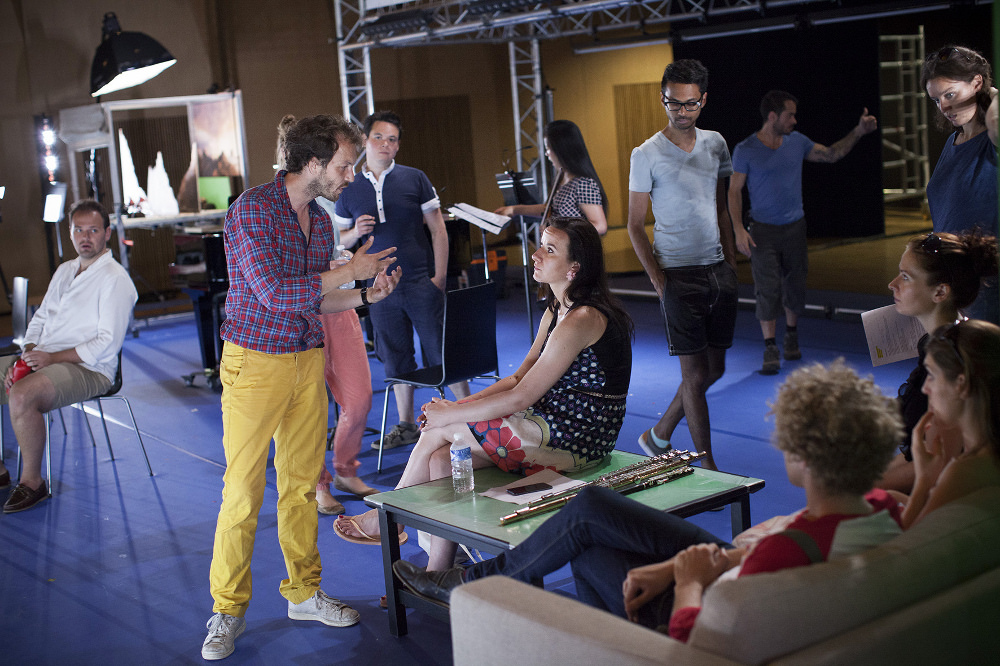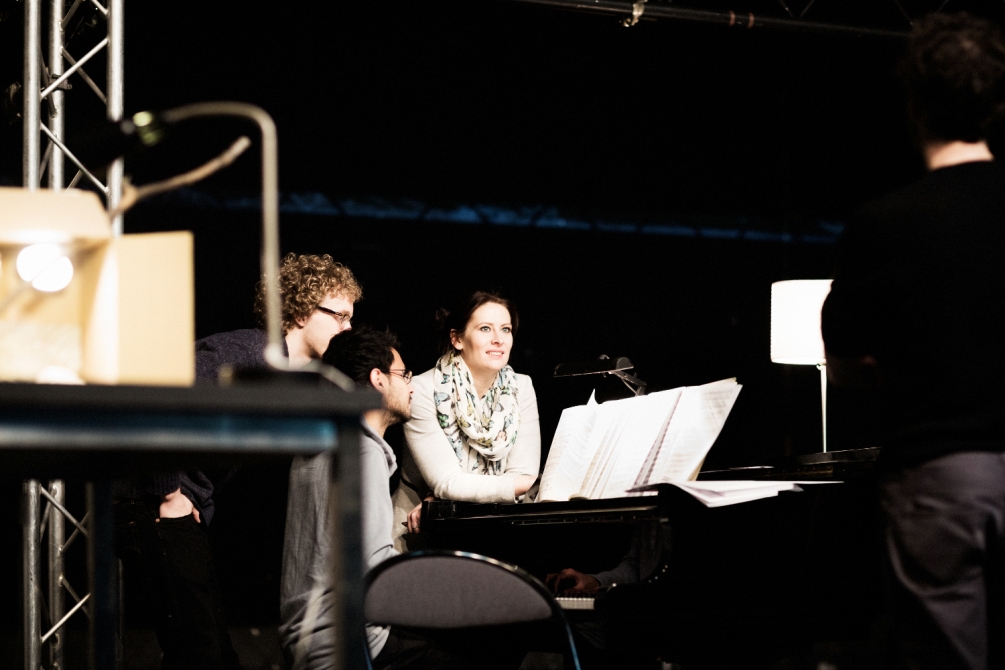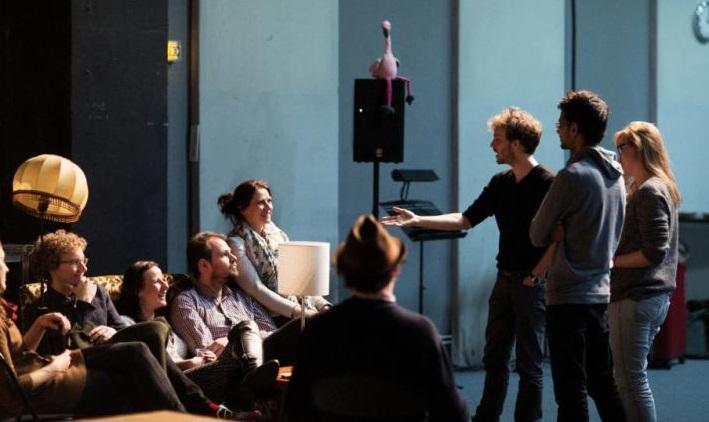It’s a brilliantly sunny January afternoon amidst a general drama of rain at an industrial park outside Aix-en-Provence, and members of a production team are gathering for the first time in the back yard of the festival’s rehearsal studios. Some have met earlier, and three of the five singers who’ll be arriving shortly know each other thanks to the connections already made through the European Network of Opera Academies. But it’s a journey into the unknown with ENOA’s fifth anniversary co-production, which will only reach its proper beginning in tonight’s Aix premiere, and hopefully develop throughout the year of touring Europe ahead.
Stage director Julien Fišera is the oldest in the company at a mere 37, with perfect European credentials (Portsmouth-born, with a French mother and Czech father). Together with Dutch-based Sri Lankan MaNOj [sic] Kamps, the musical mind behind it all, and German dramaturg Isabelle Kranabetter, he enlightens me on the basic plans for Be With Me Now while we snack on Chinese takeaway sitting under a bare wisteria in the studios’ back yard. “It’s quite a big team,” Fišera says by way of introduction. “We have five singers, four musicians, then what we call the creative team – that’s six plus another video director. There’s not one of us who lives in the same city, we’re all working on different schedules, so we’ve had a lot of Skype conversations and e-mails have flown back and forth.”
 The starting-point, a very flexible storyline devised by Fišera and Kranabetter, is a half-fantastical journey around Europe (video scene with musicians rehearsing last week, pictured right). It all begins with a production of Mozart’s The Magic Flute, a filleted Overture and Tamino’s opening scene with the Three Ladies. Then there’s a crisis as the tenor singing Tamino leaves the set, and a different series of adventures and trials begin. Where do they take us? “We follow Tamino on screen, driving and visiting different European cities. There should be a feeling of chaos and not knowing how to continue. A Bellini duet on the radio can trigger off memories, in this case of a failed relationship.” It will be the production’s job to try and piece it together again. Kamps, clearly an agile thinker, continues: “Since there’s no reason to continue The Magic Flute, where does the other music come from? A pile of scores, something on a laptop? We decided it would be done by heart by both the singers and the instrumentalists. You feel something is coming more from within. It’s technically possible but it must be communicated well in advance. So I need to spend two days with the players before they go away and memorise what we’ve chosen.”
The starting-point, a very flexible storyline devised by Fišera and Kranabetter, is a half-fantastical journey around Europe (video scene with musicians rehearsing last week, pictured right). It all begins with a production of Mozart’s The Magic Flute, a filleted Overture and Tamino’s opening scene with the Three Ladies. Then there’s a crisis as the tenor singing Tamino leaves the set, and a different series of adventures and trials begin. Where do they take us? “We follow Tamino on screen, driving and visiting different European cities. There should be a feeling of chaos and not knowing how to continue. A Bellini duet on the radio can trigger off memories, in this case of a failed relationship.” It will be the production’s job to try and piece it together again. Kamps, clearly an agile thinker, continues: “Since there’s no reason to continue The Magic Flute, where does the other music come from? A pile of scores, something on a laptop? We decided it would be done by heart by both the singers and the instrumentalists. You feel something is coming more from within. It’s technically possible but it must be communicated well in advance. So I need to spend two days with the players before they go away and memorise what we’ve chosen.”
The choice of operatic arias and ensembles has been fluctuating even before the singers physically join the process. What’s constant is the Mozart, and two new commissions from Belgian composer Daan Janssens and Portuguese Vasco Mendonça, whose brief is a five-voice ensemble to take over from the final Flute scene at the end. None of this has been written in January (and the singers still hadn’t seen the music when I met two of them in May, of which more anon).
What’s fixed is that every participant in the action owns it. The instrumentalists and technical crew will be onstage along with the actors. For the first week of the January rehearsal and the two-week period before the festival performances, everyone will be together the whole time, taking away ideas and bringing them back in the meantime. After the first run, there will be new communication and fresh ways of thinking in each European city until Be With Me Now visits the Aldeburgh fFestival in June 2016.
 It’s a curious feeling for a writer to be granted access to the first crucial day on which the team members begin to get to know each other (pictured left, participants last week). After the slight perplexity of so many seemingly nebulous ideas being thrown around, I felt more rooted and optimistic as each of the five singers was asked – unprepared, it seemed – to present and sing a musical number. Different, equally engaging personalities were revealed. Tomasz Kumiega, Polish baritone already successful at Warsaw’s Polish National Opera, was the joker, impressively self-confident and poised at the age of 23 (“we were all a bit hurt by how brilliant he is at that age, such a mature voice and presence,” joked the intellectual of the group, Royal Academy of Music tenor Gwilym Bowen, when I met up with him in London later). Kumiega sang the Count’s aria from Act Three of Mozart’s The Marriage of Figaro, the “eruption of bad things” as the baritone introduced it, “from someone who’s young and crazy, but not stupid”.
It’s a curious feeling for a writer to be granted access to the first crucial day on which the team members begin to get to know each other (pictured left, participants last week). After the slight perplexity of so many seemingly nebulous ideas being thrown around, I felt more rooted and optimistic as each of the five singers was asked – unprepared, it seemed – to present and sing a musical number. Different, equally engaging personalities were revealed. Tomasz Kumiega, Polish baritone already successful at Warsaw’s Polish National Opera, was the joker, impressively self-confident and poised at the age of 23 (“we were all a bit hurt by how brilliant he is at that age, such a mature voice and presence,” joked the intellectual of the group, Royal Academy of Music tenor Gwilym Bowen, when I met up with him in London later). Kumiega sang the Count’s aria from Act Three of Mozart’s The Marriage of Figaro, the “eruption of bad things” as the baritone introduced it, “from someone who’s young and crazy, but not stupid”.
Rannveig Káradóttir, a vivacious London-based Icelandic soprano whose company on two encounters I’ve hugely enjoyed since that first meeting, was affecting in “Je ne suis que faiblesse” from Massenet’s Manon; Bowen, her sparring partner who’d already sung with her in Monteverdi’s L'Incoronazione di Poppea at Aldeburgh, showed intelligent phrasing and excellent German in Belmonte’s “O wie ängstlich” from Mozart’s Die Entführung aus dem Serail. He’d already been getting professional work while still at college: I’d come across him in a classy Bach B minor Mass in the St John’s Christmas Festival.
Maartje Rammeloo, in training with the Dutch National Opera, fluctuates happily between musicals and opera, so she gave us a flamboyant music-theatre performance of “I want to be a prima donna”. Mezzo Kinga Borowska, the other Pole in the cast and currently singing in Brussels’ Queen Elisabeth Music Chapel, pierced the soul as Massenet’s Charlotte. Then there was a round of unaccompanied singing – inspired idea – which left the singers more exposed, but also revealed something more personal. We got, among other things, an Icelandic folksong, “Waly, waly” and a homage to the great Mathilde Santing. Introductions strikingly effected, the singers then went off to their lodgings in Aix – five hungry young people, one microwave – before their arduous week, and I took a bus back to the airport.
 Leap forward to May, and a meeting with Rannveig and Gwilym (pictured right, rehearsing with MaNOj Kamps) against the background of a certain audience arriving for an Engelbert Humperdinck concert at the Royal Albert Hall. Above the café din, the soprano and tenor spoke exuberantly of what had happened in the interim. Their roles as the two lovers who separate and meet again have taken them to filming around Europe – Paris recently, tomorrow Brussels, Ghent and a meeting with Jansson: “we’re all on tenterhooks, we need to see the new scores soon, especially the finale.” Rannveig notes, “We’ve still not much idea of how we will properly relate to each other, it’s still in development, because in the workshops they hadn’t really decided on some important things that will make the show.”
Leap forward to May, and a meeting with Rannveig and Gwilym (pictured right, rehearsing with MaNOj Kamps) against the background of a certain audience arriving for an Engelbert Humperdinck concert at the Royal Albert Hall. Above the café din, the soprano and tenor spoke exuberantly of what had happened in the interim. Their roles as the two lovers who separate and meet again have taken them to filming around Europe – Paris recently, tomorrow Brussels, Ghent and a meeting with Jansson: “we’re all on tenterhooks, we need to see the new scores soon, especially the finale.” Rannveig notes, “We’ve still not much idea of how we will properly relate to each other, it’s still in development, because in the workshops they hadn’t really decided on some important things that will make the show.”
One thing that Rannveig now knows is that she’ll accompany herself on the piano for Handel’s “Piangero” from Giulio Cesare – “I do play the flute as well but that might be slightly problematic singing at the same time”. Gwilym jokingly suggests he could offer his skills on the ukulele, a useful instrument to help him learn roles and their chord supports while on the road. We fantasise that they could have participated in an Apprentice-style film about the five singers sharing in Aix, but there’s already enough video work – the outside filming, which Rannveig enjoyed for how it took her outside her musical comfort zone, some live work on the day of each performance, and some pre-filming just before it.
Both are positive about what’s to come. “Every single person I’ve met on the project has been really lovely,” says Rannveig, “so you can’t go wrong, and I’m quite confident that it’s going to be great fun. The point of ENOA is to connect people, and I feel privileged to get to all those places and see all those people, and you never know what might come out of it, even though I am accompanying myself on the piano, not in a great costume singing an aria at the top of my lungs with an orchestra at my feet”. “And by the time we close in 2016 we will have been together for a long time,” adds Gwilym.
The European message is a good one, isn’t it? “Oh, we all need a bit of that,” says Rannveig. “Stick together, let's be friends”. “After all, it’s the most exciting aspect of opera as opposed to more monoglot and possibly more monocultural fields you could be working in,“ Gwilym adds. “You could, I suppose, say, I’ll work exclusively in English or German, but that would be difficult. And I don’t know if we’ll make a big difference to the referendum, but we’ll try our best.”
- Be With Me Now opens tonight at the Aix-en-Provence Festival before touring to Amsterdam, Munich, Warsaw, Lisbon, Brussels and Aldeburgh















Add comment